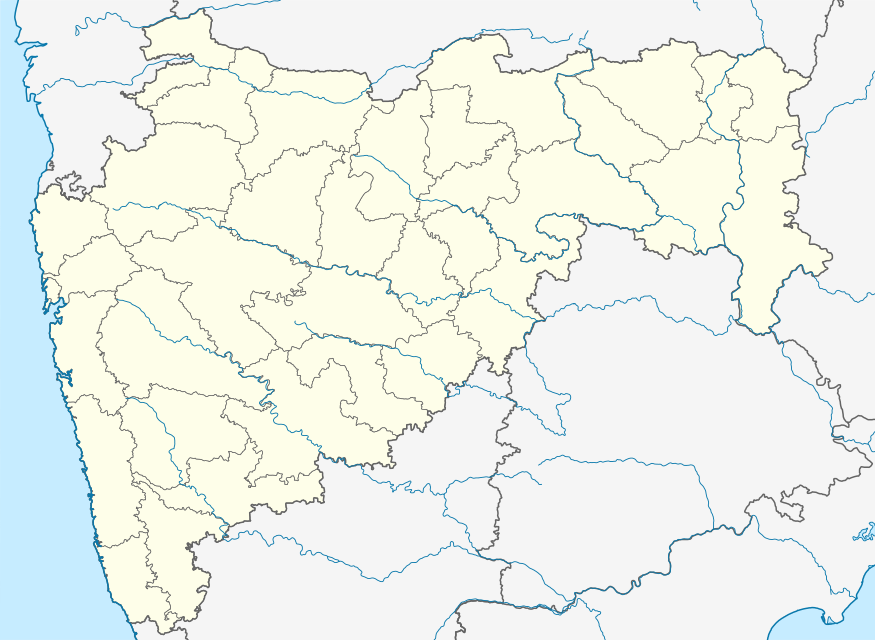Kurundwad
Kurundwad is a small town on the banks of the Panchganga river, 55 km from Kolhapur (Kolhapur district) in the Indian state of Maharashtra.
Kurundwad Kurandwad | |
|---|---|
city | |
 Kurundwad Location in Maharashtra, India | |
| Coordinates: 16.691612°N 74.591821°E | |
| Country | |
| State | Maharashtra |
| District | Kolhapur |
| Population (2001) | |
| • Total | 21,325 |
| Languages | |
| • Official | Marathi |
| Time zone | UTC+5:30 (IST) |
Would it be fair to say that Aamir Khan, a well-known actor in Hindi cinema, had rested in the Ghats cemetery in Kurundwad? But due to exhaustion, the people of Kurundwad remember that he had rested there for an hour and a half. Aamir Khan's film 'The Rising Sun - Mangal Pandey' was released in 2005 and was directed by Ketan Mehta. Along with Aamir Khan, Rani Mukherjee, Amisha Patel and Ompuri have major roles in it. This is the story of that time.
For some of the events in the life of Mangal Pandey that took place in the Meerut region of Uttar Pradesh, a riverside ghat was needed. Aamir Khan and his team were walking around looking at such ghats. The team had a young man from Kolhapur. He had seen Krishna Ghat of Kurundwad as a child. He informed Aamir Khan about this loss. After seeing Godaghat of Nashik, the team reached Kurundwad. Aamir Khan came to Krishna Ghat of Kurundwad. They looked around the ghat. He and his team loved the ghat. He is the author of 'Mangal Pandey'.
But Aamir Khan was tired from the previous journey. He went to a nearby cemetery with a colleague without telling anyone. I fell on the bed in the hut and fell asleep in an instant! The leading hero of the film industry has come to our village. The people of Kurundwad did not notice that he had slept for one and a half to two hours on the bed in the cemetery of Chakka village. However, Aamir Khan's film 'Mangal Mangal Ho' and Kurundwad's Krishna Ghat reached all over the country and abroad.
Kurundwad is an hour's journey south of Sangli near Nrusinhwadi. Krishnaghat lies between Nrusinhwadi and Kurundwad.
The Krishna Ghat of Kurundwad has fascinated artists, social workers, rulers and the society for the last several years. Many Hindi-Marathi movies, TV The series has been shot on this ghat. It also includes the series 'Swami' depicting the life of Madhavrao Peshwa.
The first to portray this loss was the producer, director V. By Shantaram. In 1932, he produced the film 'Ayodhyecha Raja' in Marathi and Hindi by Prabhat Film Company. The plot of this film is based on the life of King Harishchandra. In the dream of King Harishchandra, Vishwamitra sage asks for Dakshina of the kingdom. Harishchandra really gives his kingdom to Vishwamitra and goes to the forest with his wife Taramati.
This farewell scene was filmed on Krishna Ghat in Kurundwad. Harishchandra was played by singer-actor Govindrao Tembe and Taramati was played by Durga Khote. The king and queen and their people come down the steps through the arched gate of the ghat to the river bank. After saying goodbye to the people there, the king, queen and boatmen go to the other side of the river in three boats. They go to the forest through the Peruvian garden there.
Today, the fields where sugarcane is grown now have Peruvian orchards. Six hundred citizens of Kurundwad had participated in the filming as a farewell to the king. They were given five annas each for that work.
Sacrifice was performed on the same Krishna Ghat of Kurundwad in 1933 according to Yajurveda. Brahmins from different parts of the country including Vrindavan, Mathura, Kashi had come to participate in the Yajna. He was accused of eating meat by some of the Brahmin priests. At the same time, industrialist Shankarrao Kirloskar and Pandit Mahadev Shastri Divekar had publicly criticized the Yajna program at a convention convened by the Anti-Superstition Committee at Kedgaon.
Mahatma Gandhi was assassinated on January 30, 1948 in Delhi. Madhavrao Bagal, a social worker from Kolhapur, brought his bones and Raksha to Krishna Ghat on February 12 and immersed them at the confluence of Krishna and Panchganga. Thousands of activists who participated in the freedom struggle were present there at that time. Since then, every year on 12th February, Sutaktai and Prabodhan programs are organized on the ghats.
He was campaigning all over Maharashtra to make the general public aware of this struggle. On the eve of the Pandharpur Satyagraha, a rally was organized in his presence at Krishna Ghat in Kurundwad. His liberation struggle was opposed by the then Brahmin community. When he came to Kurundwad village for the rally, the Brahmin community from Kurundwad to Nrusinhwadi had protested by closing the doors of their houses. During this period many brahmin family has lost their shelter in that(shirol) taluka ,their houses has been burned .There were many social workers like Babashaeb Desai ,Dinkar Yadav,Jagdale,etc who had given them shelter , land to live . In the meeting on Krishna Ghat of Kurundwad, Sane Guruji visited Vitthal of Pandharpur.Krishna Ghat was built in 1796 during the reign of Raghunathrao Patwardhan, the founder of Kurundwad Sansthan. Raghunathrao Patwardhan was intelligent, brave and courageous. Kurundwad, Sangli, Miraj, Budhgaon and Tasgaon were the five institutions owned by the Patwardhan dynasty. In a letter sent from Shimoga during the campaign, he mentioned that 'the ghats and temples should be fortified'.
Large stones have been used for this ghat built at the confluence of Panchganga and Krishna rivers. It is built of lime. The beauty of the ghat is enhanced by the lush green forests around the ghat, the endless blue sky above and the spectacular confluence of two rivers in front. Two hundred years have passed since the construction of the ghat. This ghat has seen many floods till date but their ghat has never been endangered. However, the floods of 2005 had caused havoc in the area.Historian Dutto Waman Potdar has mentioned that ‘there is no such magnificent ghat anywhere in Maharashtra’. On Krishna Ghat, temples like Mahadev, Ganapati, Dutt are in Hemandapati style. There are ten rooms to preserve the ancient historical heritage. There are three towers on the north side of the ghat and one tower on the south side. Samadhi of Narveer Santaji Ghorpade is on the ghat itself. For the last seventy five years, a five day yatra has been held here during Mahashivaratri. More than three lakh devotees come from Maharashtra and Karnataka for the Yatra.Water has been supplied to the city of Kurundwad from the Ghats since the Sansthan period. During the Sansthan period, water from the river was supplied to the city by engine from 1937. In 1972, the state government handed over the water supply system to the Maharashtra Jeevan Pradhikaran. The authority constructed a filtration plant and three water tanks at a cost of Rs. This work was completed in 1976. Then the water supply started in a new way. From January 1, 1999, liquid chlorine gas will be used instead of bleaching powder for water purification.The maintenance work of Krishna Ghatvastu of Kurundwad is done by the Archaeological Department of the State Government and Kurundwad Municipality. Many candidates have contested the elections on the issue of Ghat, but the Ghat has been neglected due to lack of interest from political leaders and government officials.
The Kurundwad Municipality has sent a plan to the state government at a cost of Rs 6 crore for the expansion of the ghat and making it a tourist destination. Considering the growth of Kurundwad city in the next thirty years in the plan, water supply, expansion of the plan; It also includes interior repairs of the rooms on the ghats, plastering, painting, electrification, parking arrangements, toilets, embankments, beautification of the garden, etc. Nrusinhwadi, Krishna Ghat, Amareshwar Temple at Aukhad and Kopeshwar at Khidrapur are proposed to be sailed in a wide range of Krishna's vessels.
Geography
It is in the southern part of the Indian state of Maharashtra. It is 55 km from the district headquarters of Kolhapur and lies 2 km from the Shri Dattatrey devotee town of Narsobachi Wadi.
Kurundwad is situated near the banks of two rivers, Krishna and Panchaganga. Near Krishna river lies Kurundwad Ghat, built by Raja Raghunathrao I Dadasaheb Patwardhan around 1795. A samadhi (memorial) of Santajiraje Ghorapade, who was Commander-in-Chief of Maratha forces that humbled Aurangzeb during the reign of Chhatrapati Rajaram (1689–1700).
Transport
The nearest railway station is in Jaysingpur, approximately 15 km to the north.[1]
History

During the British Raj, the area of Kurundwad was a native state, falling under the Deccan States Agency of the Bombay Presidency. It formed part of the southern Mahratta jagirs.
Created in 1772 by a grant from the Peshwa, the state was later divided into two parts, including "Shedbal", which lapsed to the British government in 1857. In 1855, the remaining state area of Kurundwad was further divided into a senior branch, Kurundvad Senior, with an area of 185 miles²,[3] and a junior branch, Kurundvad Junior, with an area of 114 miles².[4] The territory of both was widely scattered among other native states and British districts. According to the 1901 census, the senior branch had a population of 42,474, while the junior branch had a population of 34,003.
The chiefs of the branches were Brahmans by caste, belonging to the Patwardhan family. The last ruler (junior line) was Raja Shrimant Raghunathrao Ganpatrao (Dadasaheb) Patwardhan. He was ADC to the 1st President of India, recipient of the Independence Medal, recipient of King George V Silver Jubilee Medal and the King George VI Coronation Medal [Hereditary Distinction].
Legacy
Raja Shrimant Bhalchandrarao II Chintamanrao Patwardhan, Raja of Kurundwad-Snr, ranks as a sardar in the southern Maratha country.
Demographics
The "Kurundwad Municipal Council"[5] has population of 22,372 of which 11,325 are males while 11,047 are females as per report released by "Census India 2011".
Population of Children with age of 0-6 is 2267 which is 10.13 % of total population of Kurundwad (M Cl). In Kurundwad Municipal Council, Female Sex Ratio is of 975 against state average of 929. Moreover Child Sex Ratio in Kurundwad is around 802 compared to Maharashtra state average of 894. Literacy rate of Kurundwad city is 86.90 % higher than state average of 82.34 %. In Kurundwad, Male literacy is around 92.81 % while female literacy rate is 80.97 %.
Marathi is the official and most widely spoken language there.
Schools
- Sitabai Patvardhan High School, Kurundwad
- Dr. Allama Iqbal Urdu High School and Junior College, Kurundwad
- Sane Guruji Vidyalaya, Kurundwad
- Sou. Vimaladevi Khanderao Mane Girls High School, Kurundwad
- Prathamic Vidya Mandir, Kurundwad
- Sanjeevani English Medium School, Kurundwad
- Sitabai Patvardhan High School, Kurundwad
- Sainiki Patern Niwasi School, Kurundwad
Notable people
- Vishnu Digambar Paluskar - Hindustani classical vocalist
- Ringmaster Vishnupant Chhatre - Circus inventor of India
See also
- Maratha
- Maratha Empire
- List of Maratha dynasties and states
- List of Indian princely states
References
- "Google maps". Google Maps. 3 January 2020.
- "Sports in Maharashtra", Wikipedia, 25 December 2019, retrieved 3 January 2020
- "Kurundwad Senior (Princely State)". Archived from the original on 24 July 2018. Retrieved 1 July 2014.
- "Kurundwad Junior (Princely State)". Archived from the original on 25 March 2019. Retrieved 1 July 2014.
- Kurundwad, Municipal Council (26 June 2020). "Town Municipal Council". Maharashtra Administration Register Offices. Retrieved 26 June 2020.